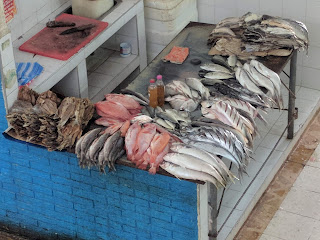The sail to Santa Marta took us just under 72 hours. We actually arrived outside of the harbor about 0600 on 12/13 but couldn’t go in until after 0800 when someone was there to answer our radio call and direct us to the dock. We sailed almost the entire way, starting the engine once a day when the wind was down so we could charge up the batteries. The autopilot tends to run it down a bit even though we had good wind and sun. We passed by a couple of freighters without any problems and saw a few other boats on AIS. Overall, we had a great 3 days of sailing. We both agreed that this was the best sail we have had thus far. I guess we are getting used to spending several days at sea. It can be monotonous at times, stressful at other times and certainly tiring when you are doing night watches. But after the first overnight passage, the consecutive nights prove much easier to get some sleep as I guess we are so tired, we can sleep through pretty much anything. Then we find as we begin to get in the groove, before we know it, the passage is over. Maybe we will actually build up to a week-long passage one of these days! As we approached the coast of Santa Marta before sunrise, the winds picked up to about 30 knots, which we learned is typical and we hove-to for a couple of hours until we could get clearance from the marina and could see clearly to enter the harbor.
We had arrived not only in a new country, but a new continent! We had never been to South America before.
 |
| A beautiful sunset the night before we reached Santa Marta |
 |
| Dawn the morning we arrived at Santa Marta (12/13/17) The Sierra Nevada mountains come right down to the sea.. |
We had to tie up to the fuel dock at the
marina first and then get assigned a slip. Greg went in with the dock-hand on a
golf cart to find our slip while I stayed with the boat. Fortunately, I had
stayed behind because the surge at the fuel dock was so strong I had to keep readjusting
the fenders. The dock hand had tied our line from the midship cleat straight
out to a cleat on the dock rather than making it a true spring line and the
surge was so strong, the perpendicular pull on the cleat began working it
loose. After retying the line forward as a spring line, the strain on the cleat
was relieved and so was I.
We usually
anchor out but decided for several reasons to use a marina in Santa Marta. The
winds can really pick up along the coast of Colombia in the winter (the Christmas
winds tend to last from November or December thru March) and for security
reasons we felt better about being in the marina which is gated and has a
security guard. So we bit the bullet and paid for a month in the marina. The
employees there were very friendly and helpful and the facilities were pretty
good. Even though the showers had hot
and cold running water, you just never knew which you were going to have from
one minute to the next. We learned how to listen for the difference in the
water pressure and turn up or down the hot water so we didn’t get scalded or
frozen. We even had wifi at the dock occasionally and almost always could get
it in the Captain’s lounge which actually had a working air conditioner the
last week we were there. But since it’s all an improvement on what we have at
anchor, we can’t complain! I even found time to take advantage of the space and
electricity in the Captains’s lounge and finally made our spray curtains
to reduce the amount of waves we actually get dumping on us in the cockpit.
They also make for nice privacy curtains when we shower in the cockpit.
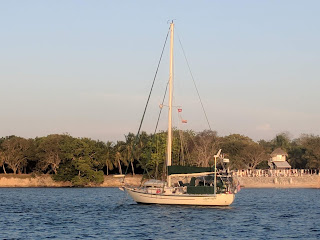 |
| Our new spray curtains along the sides of the cockpit |
Our time in
Colombia was spent doing land-based trips. Almost the entire time we were
there, we had winds in the 20 to 25 knot range during the day and 30 to 40+ at night.
Sometimes in the harbor, outside of the marina it was 60 knots at night, making
us even happier that we chose to stay in the marina. The bad part about that
was the sand from the beach and coal dust from the coal freighters would blow
onto the boat day and night and made everything filthy. We kept the hatches
closed which made it hot but we still got sand in the boat. We were constantly
wiping down the inside of the boat. Greg would clean the solar panels every day
so we could still make power. At least with all the wind, we had plenty of power through the night from the wind generator.
We were
surprised at how big Santa Marta is. We followed a couple of other cruisers
around for a few days, learning our way to the Exito and other grocery stores
and to the Mercado, the open air market and the hardware area. They group
similar businesses together in various areas of the city. We found the hardware
section and the music store areas, etc. We were amazed at how crowded the streets
were, even the pedestrian-only streets. Way more crowded than even in New York
City. It was not a place you would be comfortable walking if you were
claustrophobic. Sort of like the French Quarter on Mardi Gras day. I only did that once and that was enough! There
were stores all along the street and then little outdoor stalls lining the
sidewalks everywhere. My watch had broken and I was able to get a new one from
one of the sidewalk vendors for $4 US which I considered a huge bargain,
especially because it is still working 3 months later. We also learned that
Colombians like their music LOUD and almost constant.
 |
| The altar of the Catedral in Santa Marta. |
 |
| Being there in December gave us the opportunity to see many nativity scenes like this one in the Catedral. |
 |
| Pretty government building in one of the town squares |
 |
| Great artwork representing all the restaurants in the touristy area of Santa Marta. We actually saw the guy working on it. Notice the black area to the left with the wording, "Loading...". |
 |
| More "wall art" just to the left of the "Loading"work. |

We walked around one day in search of an ice cream shop that people had told us was very good. We finally located it on a corner in Bolivar square. it was closed. But people nearby told us it would open at 2:00 so we wandered around town some, checking out the sights and returned at 2:00. It wasn't open. Then someone said 3:00. So we wandered around some more, getting even hotter and more desirous of a nice cold ice cream. Returning at 3:00, and finding the place still closed and being painted, we said we would give them until 4:00. Meanwhile in our wanderings we came upon a place offering 2 for 1 mojitos so we decided the ice cream shop would get one more chance and then it was mojito time. You guessed it, the mojitos won out. And they were very good. We did return to the ice cream shop several times later during our stay here and it was wonderful ice cream for VERY cheap (about $1.50 for two huge scoops in a cup or cone) with a large variety of unique flavors.
 |
| Cooling off with some mojitos |
The old Mercado:
 |
| The meat vendors: everything from beef to pork, lamb, fish and chicken and a few others. |
 |
The old Mercado (Market) was actually a beautiful, open-air building with wrought iron stair railings and curved stairs and vaulted ceilings. The meats were on the first floor and hundreds of vegetable stalls were upstairs. Outside were stalls selling everything from tourist junk to clothes, umbrellas, toys, etc.
|
 |
We had three boats including ours that were part of our original group of 25 that left the Bahamas together in March, 2015 here in the Santa Marta Marina. Gavin and Catherine on Jump, Greig and Caroline on Lequesteau and us. The marina had a nice patio where we often gathered in the late afternoons for a chat. Just like we did at Chat-N-Chill in Georgetown, Bahamas. Here, we are getting ready for our cruiser Christmas Party.
|
We took a
day trip to Minca, a town about an hour away.
We booked a day long tour with Jungle Joe through a tour agency in Santa
Marta. Joe and his daughter speak very good English and between the two of
them, we had a great hike to the waterfalls, a tour and learned quite a bit about coffee, cocoa,
and coca production and uses. Joe built his house using bamboo studs and for
furniture, stairs, etc. He served us a terrific lunch on his terrace and gave
us a lesson on bamboo and its uses in construction and on cocoa. Then we toured
a coffee plantation and then a store that sells various “medicinal” products
made from marijuana and coca.
 |
| The unique outdoor bathroom at the hostel where we gathered to start the tour. |
 |
| Greig and Caroline crossing the stream |
 |
| Pretty Nativity scene on the side of the road |
 |
| Waterfall in Minca |
 |
| Enormous bamboo grew along the roadside |
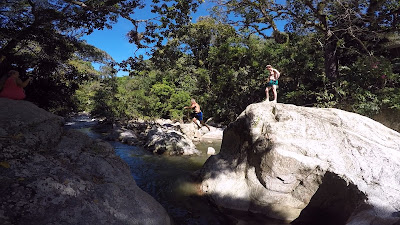 |
| Greg jumping off the rocks |
 |
| Joe fixes our lunches in his outdoor cocina |
 |
| Bamboo grown in Colombia is especially strong and is used in a lot of construction. They also use it for bookshelves, furniture and stairs. |
 |
| Mosquito netting for the beds. |
 |
| Going up the bamboo stairs |
 |
| Joe's living room |
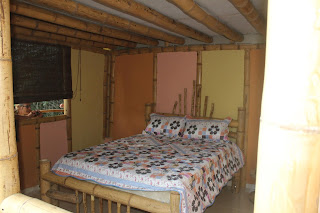 |
| Even the bed frame and the wall supports are made from bamboo |
 |
| Joe gives a presentation on cocoa pods to chocolate |
 |
| Odd sculpture along the road in Minca. Sort of reminds me of a prehistoric bird. Maybe it is a macaw. |
 |
| Another house made with bamboo |
 |
| Coffee beans growing on the coffee farm, or finca. |
 |
| Crusher to remove the pods and release the coffee beans |
 |
| "Happy Coca" beer for sale in Minca. Coca in its medicinal form or for "health benefits" is legal in Colombia. |
On Christmas
Eve, the cruisers in the marina got together and had a Christmas party with a
gift exchange and lots of yummy pot luck foods.
 |
| The gift exchange |
 |
| Greg got a bottle of rum but that didn't last long as someone "stole" it on their turn. |
We
celebrated Christmas on our boat with 3 other couples. Although we have the
smallest boat, we do have a good sized table in the main salon and since eating
outside was nixed because of the sand storms, we turned on our air-conditioner
for the day and had everyone aboard Lagniappe for dinner. Our new friends, Anne
and Jean Pierre (JP) from Rayon Vert (It means Green Flash in French) joined us
as well as old friends, Catherine and Gavin from Jump and Greig and Caroline
from Lequesteau. Everyone contributed food and we had a feast with leek and
potato soup, salad, leg of lamb, vegetables and dessert. It was filling, fun
and fabulous.
 |
| Crowded around the table on Lagniappe for Christmas dinner: me, Greg, Greig, Caroline, Jean Paul, Anne, Gavin and Catherine |
The day
after Christmas, the marina threw a party in the evening with a really great
band. They were instrumentals only but were fantastic.
 |
| The Christmas lights of Santa Marta |
 |
| Plaza Bolivar lights |
Greg and I also took
a short flight to Bogota, the capital of Colombia for New Year’s weekend. After
some initial confusion, we took the bus from the airport to the metro and took that into town and
managed to find our way to walk to the B&B using the phone’s GPS. The
elevation there is more than 8500 feet above sea level and it was pleasantly
cool. In fact, it was sleeting when we arrived at the B&B. Fortunately, we had
brought our fleece jackets and long pants! (Or “Big boy pants” as Greg calls
them.) The Spanish founded Sante Fe de Bogota in 1538, on this fertile highland
which had been inhabited by the indigenous Muisca, a very advanced
pre-Columbian people. We stayed in La Candelaria, the historic, cobblestoned
district of old Bogota. The area around our B&B was quaint, with small
restaurants, street vendors and lots of students in the area. There was a
little church, which MAY have
been the original church of old Sante Fe de Bogota at the site of the original town square,
Plazoleta del Chorro de Quevedo. It was locked so we didn’t get to look inside
but it seemed like it would be quite plain based on its external construction.
We had lunch at a great little restaurant, Rosita, on the square our first day
here and had the local specialty, ajiaco
which is a sort of chicken soup with lots of corn, potatoes and capers
in it, really good.
 |
| Church in Plazoleta Chorro de Quevedo |
We took the funicular up the mountain, Cerro
de Monserrate on Sunday with all the other pilgrims and tourists for Mass. The
church has a commanding view of the city and is quite a landmark as it sits
over 9000 feet high, looking out over the huge city of over 700,000 people.
There are all sorts of food and souvenir vendors in a market out beyond the
church so we made a day of it and had lunch up on the mountain and enjoyed the
views of the city and surrounding valley. We could also see Cerro de Guadeloupe
with its statue of the Virgin on the next peak over.
 |
| Bogota from the top of the mountain |
 |
| A beautiful view from the top. |
 |
| View of Bogota as we rode the funicular |
 |
| Passing another tram |
 |
| Going through the tunnel on the way up |
 |
| The church was very ornate and was packed. We had to stand throughout Mass. |
We visited
the Museo Botero, Museo del Oro, and the Iglesia Museo de Santa Clara. Botero,
known for his paintings and sculptures of rotund people, donated the museum on
condition that it remain free to the public. His work is strange to me in that
the people are all obese but also out of proportion. The arms are too short and
hands too small for the rest of the body, for example. Not sure what that says
about Botero or about me that I find that odd and a bit disturbing.
The Museo
del Oro was fascinating. The skill and knowledge of metallurgy and chemistry
that the ancient Muiscas and other indigenous people had was amazing. The
beautiful gold body ornamentation and other pieces were absolutely amazing and
there was just so MUCH of it! And this is what was recovered after the Spanish
had shipped so much of it to Europe hundreds of years ago!
 |
| This is a nose "ring" |
 |
| Another nose ring |
 |
| More nose rings |
 |
| A stencil was carved and used to roll a design on pottery or as a tattoo |
 |
| Image showing earrings, nose ring and chest plate |
 |
| A very ornate nose ring. The little hook at the top hooks onto the septum between the two nostrils. |
The Iglesia
Museo de Santa Clara had been a church and convent and is now a museum. The
ceiling is covered in a floral gold leaf pattern and the walls are covered in
over 150 statues and paintings. The lighting is not great as it would be in a
regular museum but the effect of the amount of artwork is overwhelming.
 |
| The incredible ceiling |
 |
| The walls are covered in art works. Even the column is ornately stenciled. |
 |
| Looking back at the choir loft |
 |
| The Presidential Palace just down the street from the Museo Iglesia |
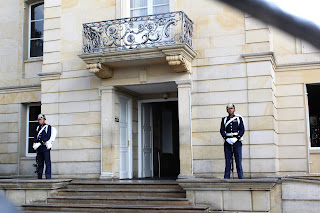 |
| The guards on duty. We wanted to see the changing of the guards but it was not happening that day. |
 |
| Greg talking to the guards outside the palace to get directions. They were actually quite friendly. |
On New
Year’s Day, our friend, Brita was in Bogota visiting her cousin and invited us
to her house for brunch. We had a really nice visit, got to know Alex and see
her beautiful apartment and met two of her friends. It was a nice New Year’s
Day, especially since we were missing our families at home. Alex showed us
where the local grocery store was and we were finally able to purchase a coffee
bean grinder (Greg’s Christmas present) as we had bought several bags of local
coffee beans for him to try and couldn’t grind them. Imagine a country known
for their coffee and the growers even recommend that you only grind what you are
going to use within 3 minutes of when you are using it and you can’t find a
grinder anywhere! We had been looking for one for a couple of weeks.
Bogota is
also known for its graffiti. They even give graffiti tours. We wandered around
and saw some amazing artwork on the sides of buildings, playgrounds, and
sidewalks.
We visited the Plaza de Bolivar and had a late lunch at Puerta Falsa, a tiny, unique restaurant just off the square.
Some interesting buildings in Bogota:
 |
| Plaza Bolivar with dome of Catedral de San Ignacio in background |
 |
| Cathedral Primada de Bogota in Plaza Bolivar |
 |
| The Plaza with the requisite pigeons. |
 |
| Liz Ann's Lunch/snack: hot chocolate with two kind of breads |
 |
| Greg's lunch. Not sure what it was, but it was good. |
We took a bus from Bogota to Zipaquira where there is the Catedral de Sal, or Salt Cathedral. It is underground in the salt mines. This was a whole day adventure. The cathedral and other carvings underground were amazing. It is all made from salt or limestone. The miners worked in dangerous conditions and felt they needed a place to pray and feel closer to God so they built the cathedral underground. The original one was destroyed but parts were transferred to the new mine and a new one was built here.
 |
| Parts of the salt mine still in operation. Most of it is several layers down. |
 |
| They have Mass here every Sunday and have another large open area for weddings and special events. |





We also took
a bus trip to Cartagena with Caroline and Greig from Lequesteau and Dan and
Melissa from Slow Dancing. Friends of Greig and Caroline’s from Canada, Kevin
and Denise met us in Cartagena and explored the city with us. We had rented an
air B&B with Caroline and Greig that turned out to be fantastic. It was a
two bedroom apartment in the old walled city area. Our little balcony looked
out over the old wall and the sea beyond. Okay, you sort of had to envision the
sea, but it was still really cool. We really liked Cartagena, the history, the
old buildings, the museums and the ambiance in general. We had some great meals here and would go
back in a heartbeat. The only negative was that the pickpockets got my wallet
which didn’t have much money in it but had my driver’s license and credit and
debit card. We cancelled the cards right away and had a new card sent to the
marina within a few days. But I am still without a driver’s license or debit
card (they can only send that to your home address). Fortunately, Greg’s debit
card did not have to be cancelled so we can still get cash from the ATM’s. I
will have to get a new license when we are home this summer. We all went back to Santa Marta on the bus
including Kevin and Denise who were sailing on Lequesteau to Panama with us.
 |
| The view form our little apartment balcony with the old wall around the city and the sea beyond. |
 |
| Checking out the local rum shop. They mix all sorts of flavors into the rum. |
 |
| Dancers in the Plaza Bolivar in Cartagena |
 |
| Some beautiful buildings around the square |
 |
| A band and dancers on another day in the square |
We visited the museum of the Inquisition which was right on the Bolivar Square.
 |
| Some of the torture devices of the Inquisition |
 |
| The gallows |
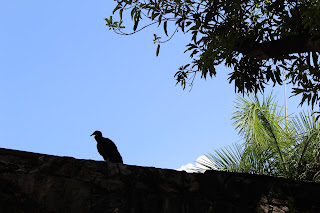 |
| A vulture waiting for his supper |
We visited the fort in Cartagena known as Castillo San Felipe, originally built in the mid 1600's. It was Spain's largest fort ever built in the New World. The fort, combined with a 7 mile long wall surrounding the old city, defended it from the likes of Francis Drake and other pirates, privateers and brigands.
 |
| Built on a high plateau, the fort had excellent views of the city and the sea. |
 |
| Cartagena from the fort |
 |
| Tunnels protected soldiers going from one section of the fort to another. |
 |
| One of the lookout towers. The fort is always jam-packed with touristas. |
 |
| The cathedral in Cartagena. Notice the huge doors with people size doors cut into them. |
Melissa and I also visited the Church and Museum of St. Peter Claver. Peter Claver was a Spanish-born monk who spent his life ministering to the enslaved people. He was known as the "Slave of the Slaves" and died here in 1654. He was the first person to be canonized in the New World. There is a museum and courtyard garden in addition to the church.
 |
| The church organ |
Walking through the old city, I noticed some interesting door knockers, so I began taking pictures of the ones I thought were unique.
 |
| I especially likes this mermaid one |
 |
| And the seahorse |
 |
| Okay, maybe this wasn't so unique. It was on the Masonic Lodge building. |
We returned to Santa Marta by bus and did a few more touristy things and then began planning to move on to Panama. Melissa and I visited the botanical garden in Santa Marta.
It is a hacienda known as the Quinta de San Pedro Alejandrino and is a botanical garden, museum and remains of a hacienda where Bolivar spent his dying days.
 |
| Not something I expected to see: bouganvilllia and cactus growing next to each other |
 |
| Remains of a rum distillery |
 |
| The kitchen. Looks like a pizza oven to me! |
 |
| The chapel in the hacienda |
 |
| Beautiful tooled leather seat on a chair |
 |
| Marble bathtub in the hacienda |
 |
| A cool walkway through the palms |
 |
| The bridge over a pond reminded me of Monet's garden in Giverny |
We made a second trip to El Bistro in Santa Marta which was a super steak restaurant. We had great steaks, drinks and desert for less than $30 per person. Unfortunately, Greg was not feeling well and didn't make it to our second visit here.
 |
| Caroline, Denise, me, Melissa, Kevin, Dan and Greig |
The next few
days were spent getting ready for our next 3 day passage to Panama. We stocked
up on provisions because we planned to be in the San Blas islands for several
weeks and supplies are limited to non-existent in some places. Friends coming
back from the States brought us some US cash so we could pay for our cruising
permits and visas in Panama (credit cards not accepted) and buy food, etc
(again cash only in San Blas and NO ATMs.) Funny how we have learned to take
that convenience for granted when we had never had ATM’s before the later
1980’s. Another cruiser met a band he really
liked and hired them to come play at the marina one evening. They were also an
instrumental group and were quite good.
 |
| Enjoying the band with Brita and Melissa |
We notified the marina of our planned departure date and waited for our
Zarpe. It took about 3 days to get it and we only got it the morning we were
planning to leave. In all fairness to the marina staff and the customs people,
the ARC boats were also in the marina and were all leaving a couple of days
before us so they were swamped with paperwork.
1/17/2018 We left
about noon and sailed 138 miles across the north coast of Colombia, past
Barranquilla and Cartagena to the Rosario islands off Colombia’s northwest
coast, arriving about 25 hours later. We had a good sail for about 8 hours and then the wind started to die. By 0330, we furled all the sails and motored for about 3 hours. About 0630, the wind was back and we sailed the rest of the way to Isla Grande in the Rosario Islands. We anchored but decided we were too close
to the channel and so we tried to start the engine again to move. It wouldn’t
start!! The solenoid didn’t click, nothing happened when we turned the
key. After troubleshooting, Greg
realized there was no power getting to the starter motor because the solenoid
was not functioning. That meant we needed a new starter or at least the
solenoid part of the starter. And we had just left all the marine supply
possibilities behind! Greg, Greig and
Kevin managed to get the starter off after much prying, cussing, brute force,
and a liberal application of PB Blaster and use of a ½ inch breaker bar. After
making several phone calls the next day to the local SSCA port captain and
finding someone in Cartagena who supposedly had the correct starter, Greg paid
some local fishermen to take him back to Cartagena (a very long, wet and
spine-jarring 2 hour ride) to get the starter. Of course, we had purposely used
up all of our Colombian money so he had to go to the ATM first and get cash for
the transportation and the starter. He got to the shop and fortunately, had
brought our starter with him for comparison. The one the guy had was not the
same one and wouldn’t even fit in the same space. He came back to the boat
quite dejected. Now we thought we would have to sail back to Cartagena, get
someone to tow us in to a marina and then order and wait for the new starter.
The next day, he put the old starter back in and decided to try and start the
engine again. We got a cough from the engine! He made a few adjustments and we
actually got it to run. I guess bouncing around in the boat ride to Cartagena,
it got something to work again. Anyway, we left the next morning for Panama and
planned to order a new starter when we got there.
 |
| Greg, Greig, and Kevin working on the starter |




